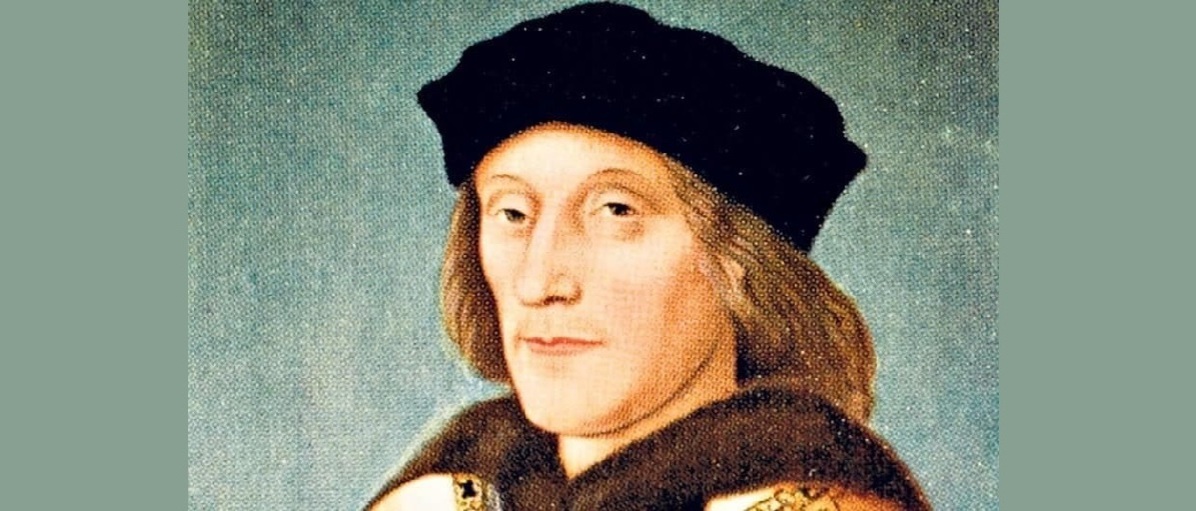Henry VII
Posted on 23rd January 2021
Henry Tudor was born on 28 January 1457 at Pembroke Castle, to Margaret Beaufort, Countess of Richmond. His father Edmund Tudor, 1st Earl of Richmond had died months before his birth.
Henry was born during the Wars of the Roses, a time of instability in England where two branches of the Plantagenet family, York and Lancaster were fighting against each other.
Henrys claim to the throne came from this mother Margaret and the House of Beaufort, although it was only a weak claim.
Henry was first placed in the care of his uncle Jasper Tudor, but this ended in 1461 when Jasper Tudor fled to France following the Battle of Mortimer’s Cross. Henry and his mother were then placed under the guardianship of William Herbert until 1469.
William Herbert was executed at the Battle of Edgecote Moor in 1469 by Richard Neville, Earl of Warwick, who had moved his allegiance over to the Lancastrian side.
In 1471 with the Yorkist Edward IV on the throne, Henry fled with others to Brittany, where he spent the next fourteen years under the protection of Francis II, Duke of Brittany.
Edward IV died in 1483 and was succeeded by his young son, who became Edward V. Due to his age, Edward V was placed under the protection of his uncle Richard Plantagenet, however Richard imprisoned Edward along with his brother and stole the throne for himself, becoming Richard III. The two children later went missing, believed murdered.
Henry was now the leading Lancastrian with a claim to the throne, and he pledged to marry Elizabeth of York, daughter of Edward IV and Elizabeth Woodville, when he came to the throne, thus uniting the warring Houses of York and Lancaster.
Henry, with French support, and accompanied by Jasper Tudor and the Earl of Oxford landed in Milford Haven, Pembrokeshire on 7 August 1485. As Wales was a known Lancastrian stronghold, their army continued to grow as they marched on to meet Richards army in Leicestershire, swelling its numbers to five thousand.
The Battle of Bosworth took place on 22 August 1485, resulting in the death of Richard III and Henry Tudor taking the throne of England as Henry VII.
Reign
Henry did not have a secure hold on his throne and fought to stabilise his position until his coronation on 30 October 1485 at Westminster Abbey. He declared himself King from 21 August, the day before the Battle of Bosworth, therefore all that had supported Richard at the battle, could be accused of treason. After his coronation, Henry declared that all that would swear allegiance to him, would be secure in their property and wealth.
Henry also went ahead with his plan to marry Elizabeth of York and they were married on 18 January 1486. A marriage that produced seven children, with only four surviving to adulthood.
Henry VII gained a country that was near bankrupt and much had to be done to build the finances.
Henry was a good administrator who enacted many new laws, and kept the allegiance of his nobles by banning private armies and enforcing high royal taxes. He was a thrifty man who believed in continuity, keeping the same financial advisers throughout his reign.
His main weapon to keep the good behaviour of his nobles, was the ‘Court of the Star Chamber’. This was a personal court ran by Privy Councillors and Judges loyal to the King. They could enact judgement quickly and harshly against any threats to royal authority, even giving punishments for an action they believed should be unlawful, even if it was in fact lawful.
Henrys reign was blighted by rebellion, but he was not a fighting man, believing instead that treaties, promoting trade and political marriages could be used to secure his position and bring peace and prosperity to England.
When Henrys eldest son Arthur was two years-old he agreed the ‘Treaty of Medina del Campo’ with Spain in 1489 which included the marriage of Arthur and Catherine of Aragon, although this marriage did not take place until Arthur was fifteen.
He also agreed the ‘Treaty of Perpetual Peace’ with Scotland in 1502, betrothing his daughter Margaret to King James IV of Scotland.
Henry had Justices of the Peace appointed in each parish in the country to enforce the laws of the land. It is during the rule of Henry VII, that the powers of the Justices of the Peace increased and by 1509 they were the key enforcers of law and order.
In 1502 Arthur, Prince of Wales died suddenly after less than six months of marriage to Catherine of Aragon, putting a strain on the Anglo-Spanish alliance. To maintain this alliance Henry VII agreed to a marriage between his ten year-old son Henry Tudor, now his heir and Arthurs widow Catherine of Aragon, although this marriage would need a dispensation from the Pope.
In 1503 Henrys wife Elizabeth of York died shortly after the birth of her seventh child and Henry took the death badly. They had married for political reasons, but became very fond of each other having a successful marriage.
Henry considered marrying again to produce further heirs, but these plans came to nothing.
Henry died on 21 April 1509 at Richmond Palace and is buried at Westminster Abbey, next to his wife Elizabeth.
He is remembered as being ruthless in his collection of taxes, thrifty in his government spending and excellent in his financial administration abilities. He left his son Henry VIII a stable government with a wealthy treasury.
Tagged as: Junior Tudors
Share this post:





